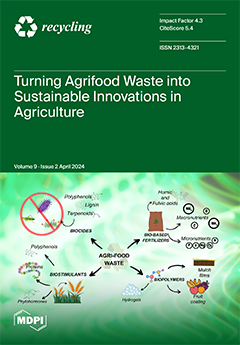Cotton stalks are residual biomass resulting from cotton bud harvesting, and they are composed primarily of lignocellulosic material. This material could be a source of functional polyphenols. To investigate this prospect, this study was undertaken with the view to examining whether an ethanol-based
[...] Read more.
Cotton stalks are residual biomass resulting from cotton bud harvesting, and they are composed primarily of lignocellulosic material. This material could be a source of functional polyphenols. To investigate this prospect, this study was undertaken with the view to examining whether an ethanol-based organosolv treatment could be suitable for producing extracts enriched in polyphenolic compounds. To this end, alkali catalysis was employed, and two catalysts, sodium hydroxide and sodium carbonate, were tested. The initial approach based on treatment severity showed that both catalysts may be equally effective in the recovery of polyphenols, yet in most cases studied, no clear trend between treatment severity and total polyphenol yield was recorded. The following study, based on response surface methodology, provided optimized conditions for both treatments, sodium hydroxide and sodium carbonate, where the recommended catalyst concentrations were 0.67 and 4%, respectively. Under a constant temperature of 90 °C and residence time of 300 min, the treatments with sodium hydroxide and sodium carbonate afforded total polyphenol yields of 18.4 ± 1 and 15.6 ± 1.9 mg CAE g
−1 DM, respectively, which showed no significant statistical difference (
p > 0.05). However, high-performance liquid chromatography analyses revealed that the sodium carbonate-catalyzed treatment produced extract particularly enriched in two hydroxycinnamate derivatives, ferulic and
p-coumaric acid. This extract also exhibited increased antioxidant activity. The outcome of this study strongly suggests cotton stalks as a bioresource of functional substances, while mild alkali-catalyzed ethanol organosolv treatment appears to be a very promising technique for effectively delivering hydroxycinnamate-enriched extracts.
Full article





